Pakhira: description and conditions of keeping the flower
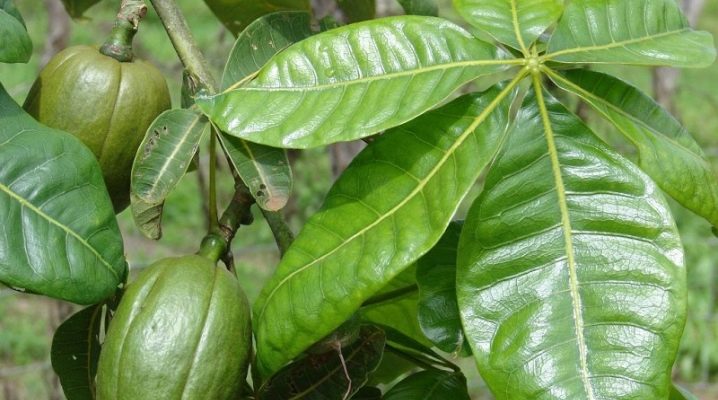
Pakhira is a beautiful exotic tree that will easily fit into the interior of an apartment or office. Having learned the basic rules for caring for a palm tree, anyone can grow it on their site.
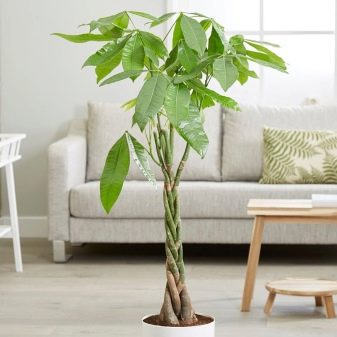
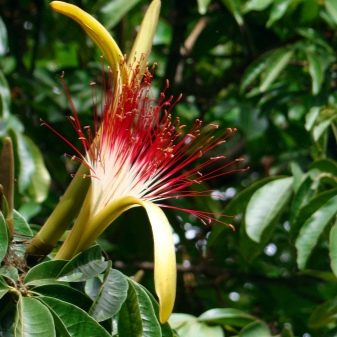
Description of the plant
In the wild, pachira is found in places with warm and humid climates. Most often, it grows in swampy areas. This plant is often referred to as the money tree or bottle tree, as well as the Malabar chestnut. This type of palm belongs to the Malvov family. In nature, the plant can grow up to three meters in height. At home, it develops much more slowly. With proper care, a culture can live for several decades. Pakhira is a non-poisonous plant. Therefore, it does not need to be isolated from pets and children. The indoor tree blooms very rarely. But at this time, the plant looks very beautiful.
The tree is covered with narrow, long flowers, collected in large inflorescences. Their aroma is very pleasant. After the end of flowering, fruits appear on the tree. They have an elongated shape and a pleasant olive color. When the fruits are ripe, each of them splits in the middle. At this time, seeds are visible inside. Each of the fruits contains 15 to 25 seeds, covered with a dense brown skin.
These fruits can be eaten. They are also often used to make drinks that taste like cocoa or hot chocolate.
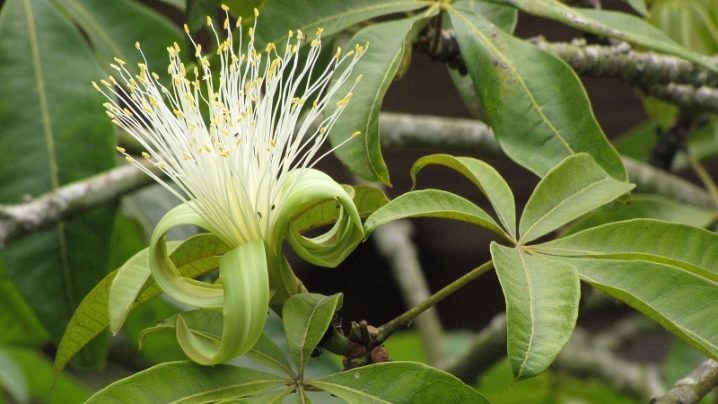
Varieties
There are several types of pakhira in nature that are suitable for growing at home. The most popular are the following varieties.
- Pakhira Aquatica. This flower is also called water pakhira. Even busy gardeners can buy the plant, because this variety tolerates drought well. There is a moisture reserve in the lower part of the tree trunk. The foliage of this tree is similar to chestnut. Her color is dark green.
- Silvery... This plant can be recognized by the small silvery stripes on the foliage. The rest of the named palm variety is similar to the previous one.
- Round-leaved... This is a beautiful ampelous plant with long creeping shoots. This type of pakhira is quite rare. Flower shoots are covered with round leaves. The plant is commonly used to decorate shop windows and offices.
The first two varieties of indoor trees are used to create bonsai.
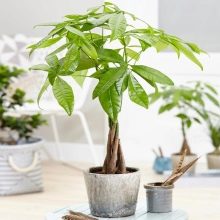

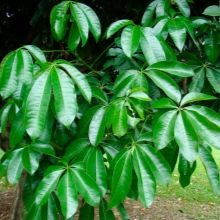
Growing conditions
When planning the maintenance of pakhira at home, you need to know in advance the peculiarities of caring for this exotic tree.
Location
To begin with, it is important to choose a suitable place for this houseplant. Pakhira does not react well to direct sunlight. Therefore, it should not be left in the most illuminated place in the room. The room temperature should be within 25 degrees. In winter, it can drop to 15 degrees. The flower should never be placed in a draft. In addition, it should not be located near radiators or heaters. This will lead to the fact that the foliage of the plant will begin to dry out, turn yellow and fall off. It will be very difficult to save him.
For the plant to always look good, the room in which it grows must be lit. With a lack of sunlight, the stems of the palm tree begin to stretch. This negatively affects the appearance of the plant.
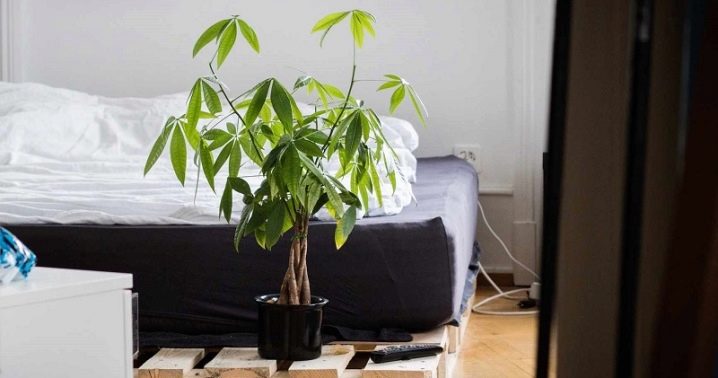
Priming
An equally important role is played by the preparation of high-quality soil. It should be loose and breathable.... At home, the soil is prepared from a mixture of clean sand, turf and leafy soil. All components are mixed in equal proportions. Some growers add small amounts of charcoal to the soil. This helps to protect the plant from pests. Instead of homemade soil mixture, you can use a purchased one. Soil for palm trees and dracaena is sold in many gardening stores.
A drainage layer must be laid on the bottom of the container. As a rule, flower growers use expanded clay and river pebbles for this purpose. From above, all this is sprinkled with a dense layer of soil. Pakhira should be planted in a medium-sized pot. A small container will hold back the growth and development of the flower. In a large pot, the plant will feel uncomfortable. The capacity for planting pakhira should be chosen based on the size of the already purchased flower, as well as its root system. Only in this case it will be possible to make the most correct choice.
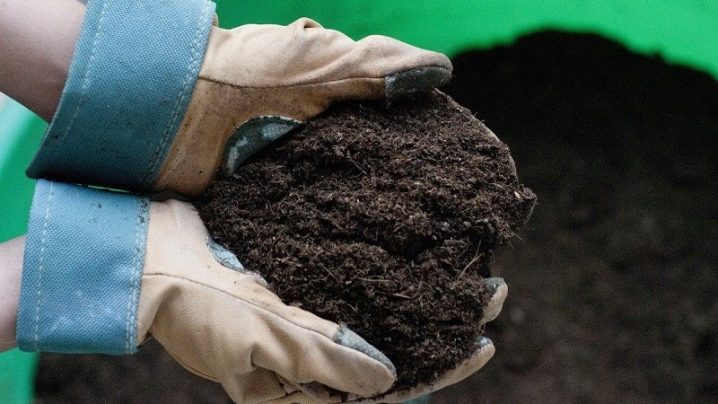
Planting and transplanting
The pakhira bought in a flower shop must be transplanted into a new pot immediately after purchase. Landing takes place as follows.
- Pakhir must be carefully removed from the pot. A lump of earth must be kneaded with your hands. After that, the flower must be shaken to free the rhizome from excess soil.
- Then the roots must be immersed in a container of warm water for 15 minutes.
- Having cleared the rhizome from the remnants of the earth, it is necessary to shorten it slightly by cutting off the edges.
- After that, the plant can be placed in a container with prepared soil. The roots must be carefully spread and covered with earth.
The transplanted plant takes root very quickly in a new place. Since pakhira develops rather quickly, it needs to be transplanted regularly. Each new pot should be larger than the previous one. The process of replanting a small palm tree consists of the following steps.
- First you need to remove the plant from the old pot. Its roots must be slightly shaken off the ground and carefully examined. Next, you need to remove all the dead or damaged parts of the flower by pests.
- A thick layer of drainage should be poured into the bottom of the new pot. It must be sprinkled on top with a suitable soil.
- Next, the pakhira needs to be placed in a prepared pot. Sprinkle the roots of the tree with the remaining earth. There is no need to compact the soil. Immediately after transplanting, the plant must be watered. When the soil settles, add a little more earth to the container.
After transplanting, the plant must be transferred to a shaded area. There should be no drafts in the room.
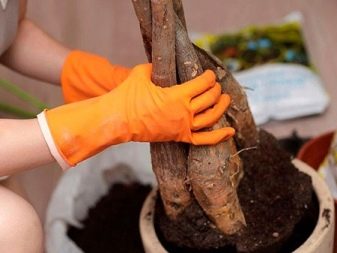
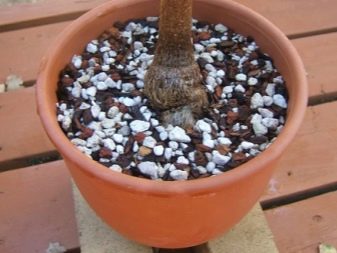
Watering
Regular watering helps keep plants in good condition at all times. Water for this purpose should be used warm and settled. You need to pour it into the pot in a thin stream. It is very important not to hit the barrel while doing this. In summer, the plant is watered about once a week. In winter, the amount of irrigation is reduced. If you wet your crop too often during the cold season, it will feel worse.
A tropical plant is also needed spray regularly... Especially if it is located in a room with dry air. This procedure must be carried out carefully, without touching the source of crown growth. Otherwise, the plant may start to rot.
For spraying, it is also worth using warm, settled water.
Pruning
The pakhira crown grows very quickly. Therefore, the flower needs regular pruning. It is usually carried out in spring or early summer. Removing shoots does not take much time. All a florist needs to do is to remove all stretched or dried branches. You need to cut them with sharp tools. Scissors or a knife must be disinfected before use. You need to cut off the shoots correctly. This should be done in one precise movement.

Top dressing
To improve the decorativeness of the plant, the soil in which the pakhira grows must be regularly fed.For this purpose, you can use both mineral fertilizers and organic ones. The easiest way to feed a flower is to use commercial products designed specifically for palm trees and dracaena. Such fertilizers are applied following the instructions on the package. Instead of purchased compositions, flower growers may well use organic matter. The following products are suitable for feeding pakhira.
- Sugar... To prepare a sweet solution, a tablespoon of sand is diluted in a container with 500 ml of water. The resulting composition of the plant can be watered at any time of the day.
- Coffee grounds... Top dressing with coffee grounds also affects the condition of the plants. To fertilize pakhira, you can use the product left over from the preparation of the drink. The thick is carefully poured directly to the roots. The main thing is that the water is not hot.
- Oranges... For a simple citrus top dressing, peel the orange. Its zest is poured with boiling water. In this form, the product is infused for several hours. After that, the cooled product can be filtered and used to water the plant.
- Ash... This versatile mixture is suitable for feeding many plants. Indoor flowers are usually fertilized with ash infusion. For its preparation, dry clean ash is poured with warm water. The solution is usually infused during the day. After that, it is filtered and used for watering.
Plants are fed no more than 1-2 times per season. Pachira is especially in need of nutrient enrichment during flowering.


Crown formation
Most flower growers give the pakhira crown an oval or spherical shape. It is in this form that the plant looks best.... To get a beautiful decorative tree, the grower can also braid its trunk. To do this, several young plants are intertwined and fixed in this position. They grow together very quickly.
When weaving cuttings, it is important not to overtighten them. This can lead to disruption of sap flow and death of young plants. If, in the process of growing cuttings, the florist carefully removes the bark at the point of contact of individual trunks, the tree will look even more beautiful in the future.
Reproduction
A home-grown palm tree can be propagated in several basic ways.
- Cuttings... The most popular propagation method for this exotic flower is cuttings. It is most convenient to increase the number of plants in this way in August. At this time, the upper stalk must be cut off from the plant. He should already be lignified. It is important that there are a large leaf and a bud on its surface. The cut cutting is immediately placed in a container with a mixture of peat and sand. Then it is covered with a film. In such greenhouse conditions, the stalk develops much better. A makeshift greenhouse should be regularly ventilated and the soil should be moistened. Once the cutting is rooted, it can be transplanted into a new pot. The landing capacity should be chosen small.
- Seeds... Planting material can be purchased at a gardening store or collected by yourself. In the second case, a person will have to wait for the plant to bloom and the seeds are fully ripe. The seeds are best used for planting immediately after harvest. After all, the longer they are stored, the lower their germination capacity. The seeds do not need to be pre-processed or germinated. All you need to do is fill the container with a mixture of sand and peat and spread the planting material on top. It is not necessary to deepen it. Sprinkle the seeds on top with a thin layer of soil. Next, a container with seeds is sprayed with warm water from a spray bottle and covered with glass. The greenhouse is also regularly ventilated. After the first shoots appear, the glass must be removed. As soon as the seedlings get stronger, they need to be planted.
Plants grown from cuttings or seeds look just as beautiful as store-bought plants.
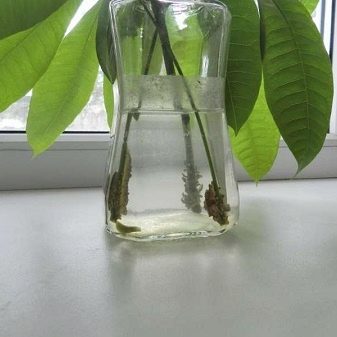

Diseases and pests
Like other houseplants, pakhira can be sore. The following diseases pose the greatest danger to her.
- Root rot. The main reason for the development of this disease is too frequent watering. The base of the trunk of an ailing plant is covered with black mold. It is quite difficult to save an indoor tree that has rotted. First of all, you need to remove the damaged part of the plant and transplant it into a new container with high-quality soil. The trunk and foliage must be treated with a high-quality fungicide before transplanting. In the future, it is very important to monitor the condition of the soil and avoid waterlogging.
- Sunburn... If the plant is in direct sunlight for a long time, its leaves quickly turn yellow and curl. Their tips dry out in a short time. The flower does not need special treatment. The grower only needs to remove the damaged foliage and move the plant to a darker place. The indoor palm will recover very quickly.
Small pests are also dangerous for indoor flowers.
- Spider mite. This insect usually settles on the back of the leaf. The pest braids the plant with a light web. Therefore, it is very easy to notice traces of his activity. The pest feeds on the sap of the plant, making it weaker. Noticing leaves in yellow spots, covered with a thin cobweb, the greens must be carefully sprayed from a spray bottle, and then wiped with a soft cloth or cotton pad. After this, the plants must be treated with any insecticide. Spraying should be done outdoors or in a well-ventilated area. You need to work in protective gloves and a mask.
- Shield... Brown-shelled insects also feed on plant sap. Because of this, the bushes are actively shedding their leaves. Pests from green foliage are carefully removed with a napkin dipped in soapy water. This procedure is repeated several times until the pests disappear completely.
- Aphid... These small insects also often damage young plants. As a rule, this happens if the pakhira grows next to other indoor flowers. To combat it, you can use folk remedies. Most often, the tree is sprayed with soapy water. Its sticky drops destroy the shell of insects, killing them in a short time. It is also necessary to process plants with such a composition several times in a row with a break of 4-5 days.
Pakhira does not need preventive treatment.
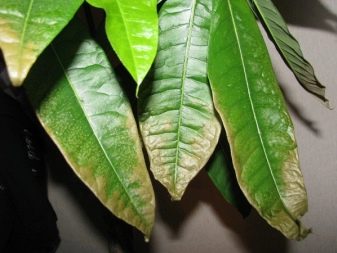

Interior use
- The decorative tree can be placed in any room. Feng Shui fans believe that this plant can attract good luck and material well-being to the house. Therefore, it is recommended to put this flower next to the workplace, in the living room or in the corridor.
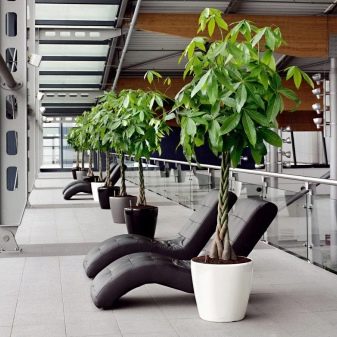
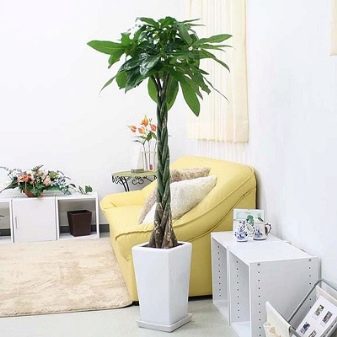
- The tree looks beautiful both alone and next to other similar flowers or green ferns. The main thing is that the chosen neighbors do not interfere with the plant's growth and development. A container with a room palm tree looks beautiful both on the floor and on a shelf or windowsill.
In general, pakhira is a rather capricious plant. But if you take care of it correctly, then the indoor palm tree will delight everyone around you with its attractive appearance for a long time.

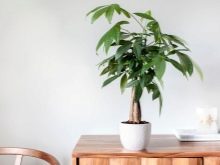
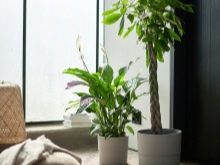







































































































The comment was sent successfully.